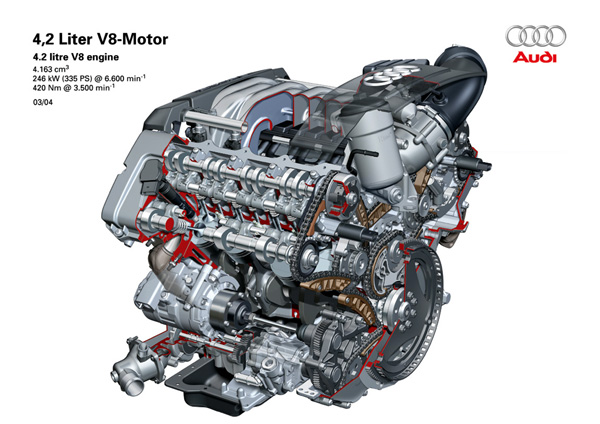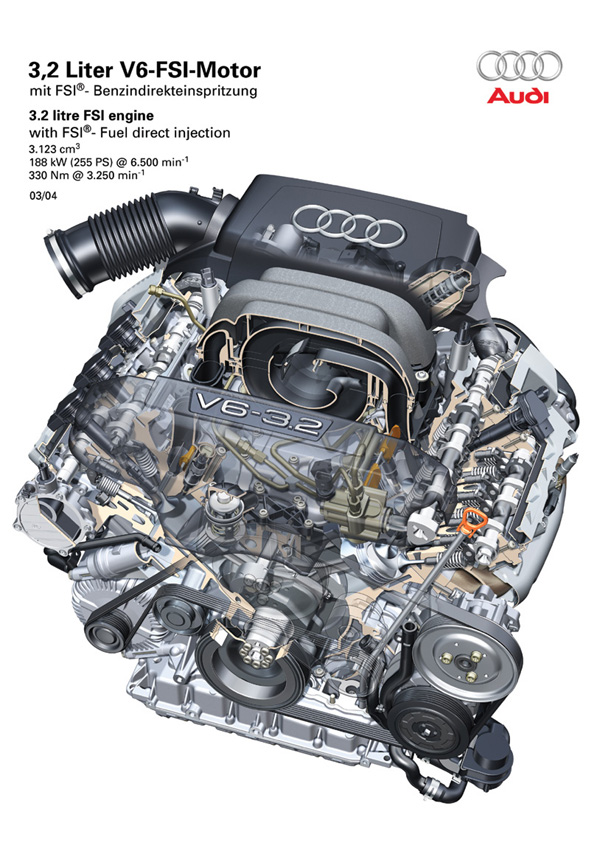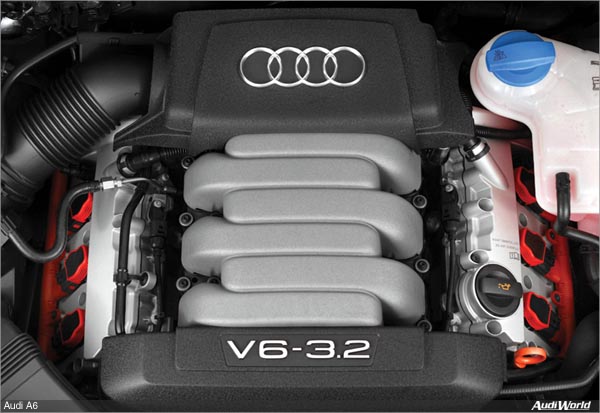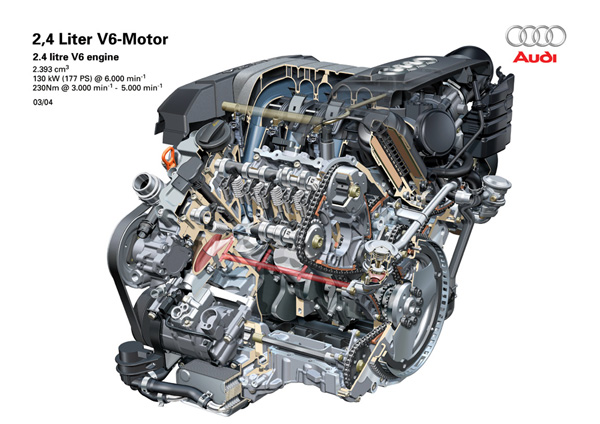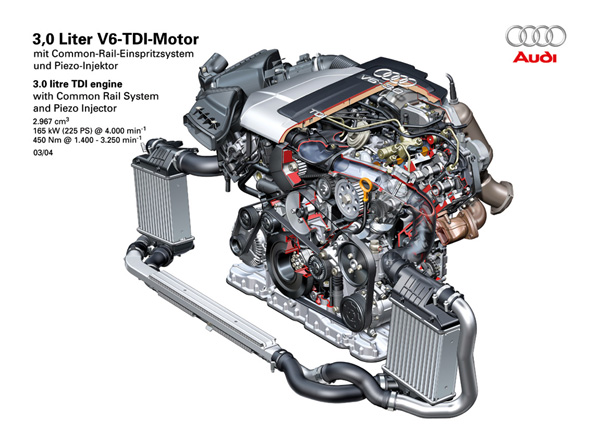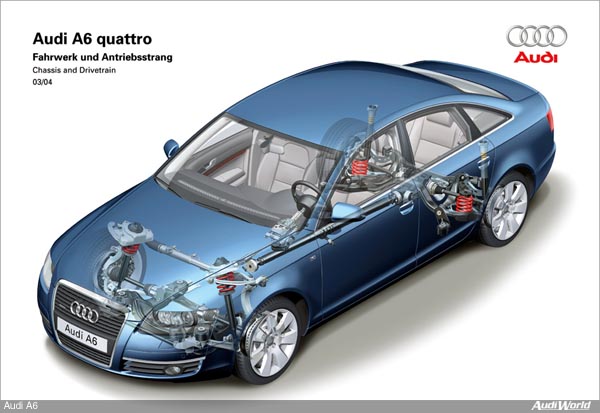The New A6: Drivetrain
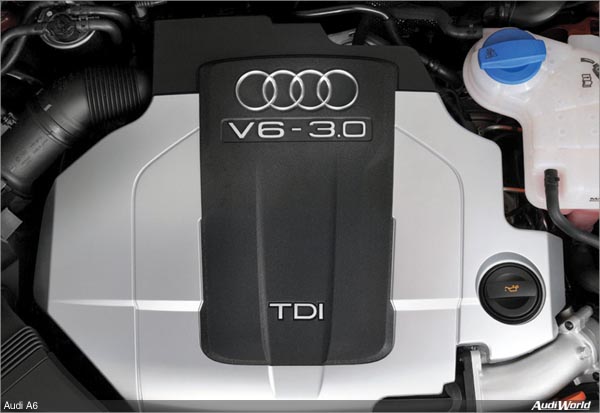
The Audi A6 is entering the market with a choice of no less than five power units – three petrol and two TDI engines – fitted lengthwise in the car. A feature shared by all these engines is the superior power and torque they offer within the respective segment: All of these engines are new in their current configuration and naturally comply in full with the EU4 emission standard. The six- and eight-cylinder power units come from Audi’s new range of V-design engines with a 90o cylinder angle and a distance of 90 millimetres between the cylinders. Other outstanding features are the compact design of the engines, maintenance-free camshaft drive by a chain, as well as low-friction roller arm valve drive. Petrol engines
4.2 V8 The powerful 4.2 V8 with chain drive made its widely acclaimed debut in the The engine excels not only through its superior output of 246 kW/335 bhp at The new A6 4.2 quattro accelerates to 100 km/h in a mere 6.1 seconds, then continuing smoothly and full of power all the way to the car’s top speed limited electronically to 250 km/h. Composite fuel consumption in the EU combined cycle is just 11.6 litres of Super Plus per 100 km/h. The unusually short and compact dimensions of the engine are equally impressive, particularly the overall length of just 464 mm enabling the engine to fit snugly into the engine compartment without having to enlarge the dimensions of the car at the front, as was the case on the former model. An additional advantage is that, weighing a mere 195 kg, the entire V8 power unit is extremely light. On the road, this means significant benefits in terms of both balance and driving dynamics. To provide this compact design, Audi’s engine development specialists have fitted a chain drive for both the camshafts and auxiliary systems on the output side of the engine, thus reducing overall length compared with the previous engine of the same size by no less than 52 millimetres. Building this new power unit, Audi’s engineers have also saved in terms of weight: piston weight is down in each case by 70 grams to 392 grams, the weight of the connecting rods has been reduced by 66 grams to 501 grams. Improvements of this kind provide the basis for the engine’s low friction and allow a maximum engine speed of 6800 rpm. The V8 power unit breathes through a two-stage variable intake manifold made of a special synthetic material. The length of the oscillating tube in torque position is 705 mm, then growing shorter to a length of just 322 mm for maximum power. Bosch Motronic ME 7.1.1. now upgraded to an even higher standard of perfection ensures superior engine management, providing the option to activate the starter electronically, with the driver being able to start the engine simply by pressing a button and without using a key (advanced key). Exhaust emissions are cleaned by two multi-stage catalytic converters positioned close to the engine in order to warm up quickly. Thanks to the efficiency of this system, the new Audi A6 4.2 easily outperforms the EU4 emission limits also when fitted, as standard, with quattro drive and tiptronic transmission.
3.2 V6 FSI A new six-cylinder is making its world premiere: the new 3.2 V6 FSI, now making its production debut in the new generation of the Audi A6, boasts all the fortes of an ultra-modern petrol engine: FSI direct petrol injection with on-demand fuel supply, four-valve technology, a variable intake manifold, as well as infinite camshaft adjustment on both the intake and exhaust sides. Maximum output is 188 kW (255 bhp) at 6500 rpm, maximum torque 330 Newton-metres at just 3250 rpm. The A6 3.2 FSI with six-speed manual gearbox and front-wheel drive accelerates to 100 km/h in 6.9 seconds, its top speed is limited electronically to 250 km/h (also on the version with quattro permanent four-wheel drive and six-speed tiptronic transmission). More than 90 percent of the engine’s maximum torque is available throughout a wide speed range from 2400 – 5500 rpm, a truly unique feature on a naturally aspirated V6 engine. On the road, this means dynamic and powerful response to every movement of the accelerator pedal and a wide range of engine speed up to 7200 rpm. Added to this there is powerful torque and superior fuel economy: average fuel consumption of 9.7 litres of Super grade fuel per 100 km is the best proof of this engine’s outstanding efficiency and the special power and performance of FSI technology. FSI engines develop more power and dynamic performance than conventional engines with indirect fuel injection – and they do so with a very high standard of fuel economy. Boosting efficiency in this way, Audi is opening up a new dimension in terms of petrol engine operating efficiency, once again demonstrating the “Vorsprung durch Technik” so typical of the brand. In June 2001 Audi’s FSI direct petrol injection system proved its unique potential in what must probably be the most challenging endurance test in the world: a power unit with FSI direct injection drove the Audi R8 to victory in the Le Mans 24 Hours. Winning this legendary race, the Audi R8 benefited from FSI technology not only in terms of extra power, but also and above all through the reduction of fuel consumption by eight percent allowing longer intervals between refuelling stops. The drivers also agreed that their freedom to “dose” engine power is much better on an FSI racing engine than with the usual racing machines. And now precisely these qualities and fortes are entering the executive class in the guise of the 3.2 FSI. How does FSI technology differ from a conventional power unit? The answer to this question becomes clear as soon as we focus on the engine’s central feature of “direct petrol injection”: contrary to an engine with indirect injection, fuel is injected in this case directly into the combustion chambers. A common rail high-pressure injection system with a newly developed single-piston high-pressure pump operating exactly on demand ensures exactly the right supply of fuel, delivering precisely the volume required for building up operating pressure between 30 and 100 bar. In the intake stroke also comprising the two-stage variable intake manifold, moving charge motion flaps provide the necessary tumble effect swirling the air around. Together with the optimum geometry of the combustion chambers and the dosage of fuel injected with supreme accuracy down to the last millisecond, this allows a significant increase in compression: while conventional production engines generally have a compression ratio of not more than 10.5:1, the compression ratio on Audi’s 3.2 FSI power unit is 12.5:1 – a record on production cars and the essential prerequisite for the new engine’s high standard of efficiency.
New engine design Completely new in its design and configuration, the 3.2-litre V6 ensures highly compact dimensions: measuring only 360 millimetres in length and 430 millimetres in width, and weighing a mere 169.5 kg thanks to the consistent use of aluminium, the engine offers significant benefits in terms of driving dynamics. Like on Audi’s new V-configuration engines in general, the cylinders are arranged at an angle of 90o and the distance between cylinders is 90 millimetres. Cylinder bore of 84.5 millimetres and cylinder lift of 92.8 mm add up to an overall engine capacity of 3123 cc. The four-valve cylinder head with a side opening for the injection valve is another special feature designed specifically for this 3.2-litre power unit. Both the intake and outlet camshafts come with variable adjustment ensuring both maximum output and the widest possible range of high torque. The camshafts, oil pump and balance shaft are all driven by four-piece chain drive of the same type as in the 4.2-litre eight-cylinder unit. Exhaust management in the 3.2 FSI power unit is optimised by two ceramic catalytic converters positioned close to the engine. As a result, this high-performance power unit easily fulfils the EU4 emission standards. Fine-tuning of the exhaust system offers the driver yet another bonus: the sporting but never irritating sound of a genuine six-cylinder unit making the qualities of the engine a truly sensual experience. The Audi A6 3.2 FSI with front-wheel drive is available with a manual six-speed gearbox. The permanent quattro four-wheel-drive model, in turn, comes with a choice of either manual six-speed transmission or six-speed tiptronic, whatever the customer prefers.
2.4 V6 Yet another new engine is making its world debut in the new A6: the 2.4 V6 is the smaller version of the 3.2-litre power unit reduced in size and featuring intake manifold fuel injection. In all, the two engines differ through just 33 components including – apart from the combustion process as such – the intake manifold and the two-stage variable intake pipe. Considering this close resemblance, it is no surprise that the smaller of the two six-cylinder units has all the basic virtues of the 3.2 FSI: sporting character combined with exemplary smoothness and refinement, plus a high degree of all-round efficiency. The engine’s silky-smooth refinement free of vibration results, as on the 3.2-litre version, not least from the balance shaft module able to very efficiently eliminate any vibrations. Cylinder stroke of 77.4 mm and bore measuring 81 mm add up to provide overall engine displacement of 2393 cc. In terms of power and torque, this means maximum output of 130 kW or 177 bhp at 6000 rpm and maximum torque of 230 Nm between 3000 and 5000 rpm. This kind of power from the new V6 obviously guarantees sporting performance in every respect: acceleration to 100 km/h comes in 8.9 seconds, top speed is 231 km/h. Composite fuel consumption, in turn, is 9.7 litres of Super grade fuel per 100 km. And like all the engines in the new A6, emissions remain well below the EU4 limits. The front-wheel-drive Audi A6 2.4 is entering the market with six-speed manual transmission and will also be available with Audi’s continuously variable multitronic transmission from mid-2004. TDI power units
3.0 TDI Introducing the new three-litre six-cylinder, Audi now offers a genuine power machine in the sporty business class, an engine with more than impressive power and torque compared with the competition: maximum output is 225 bhp, maximum torque 450 Newton-metres. And this maximum torque cuts in at just above idling speed, starting at 1400 rpm to give the driver supreme power and acceleration at all speeds. Even with the torque-converter automatic transmission, this means performance on the road even many a sports car will find hard to match: acceleration to 100 km/h comes in just 7.3 seconds, top speed of the A6 3.0 TDI quattro is 243 km/h. Other outstanding virtues of this superior power unit are exemplary noise control and fulfilment of the strict EU4 emission standard. Featuring turbocharger technology and map-controlled, cooled exhaust gas recirculation, this V6 four-valve power unit is the first six-cylinder TDI in Audi’s new family of V-configuration engines. Both the camshafts and the oil pump, incidentally, are driven by chains. Like all engines in Audi’s new V-generation, the V6 TDI has extremely compact dimensions, engine length, for example, measuring a mere 444 millimetres. A further important improvement is the reduction of overall engine weight to just 219 kilos, making the 3.0 TDI one of the lightest V6 diesels in the world. This benefits not only the car’s power-to-weight ratio, but also the weight distribution – two factors crucial to the superior driving dynamics of the new A6 3.0 TDI quattro. Common rail technology with piezo inline injectors Fuel is supplied by the latest generation of common rail technology featuring a separate high-pressure pump and rail for each row of cylinders. This increases maximum injection pressure to 1600 bar, 250 bar more than with former common rail systems. This high injection pressure serves to atomise the fuel even more efficiently, ensuring an even better fuel/air mixture and an even more efficient combustion process. Without doubt, the piezo injectors are the most important innovation featured by this new common rail system, with the injection process benefiting from the piezo effect: the electric voltage generated in the process goes through ceramic units changing their crystalline structures as a result. This leads to a very minor change in geometry which, interacting with a hydraulic control unit, serves to mechanically open the injection jet needles. Piezo injectors offer a number of advantages over conventional solenoid valves, the moving weight of the injector needles, for example, being reduced by no less than 75 percent from 16 to 4 grams per needle. This, in turn, allows a much smaller injection volume dosed with far greater accuracy – and a further advantage of piezo technology is the higher speed of the injector needles. With this technology, the number of injection cycles per operating stroke can be varied almost at random, Audi’s TDI development specialists opting for up to five injection cycles on the 3.0 V6: in addition to the main injection stroke, there is double pilot injection in the lower and single pilot injection in the medium engine speed range. This is then followed by a single after-injection stroke up to an engine speed of approximately 2500 rpm and maximum part load. This strategy serves not only to reduce emissions, but also to make the entire combustion process even smoother and softer – which also means better engine acoustics: the 3.0 TDI power unit is not only much quieter and smoother than its predecessor, but also without doubt sets the current benchmark in its class in this respect. Turbocharger with two intercoolers An optimum charge cycle under all operating conditions is ensured on the 3.0 TDI six-cylinder by a turbocharger fitted for reasons of space within the inner-V of the engine. And to enhance efficiency to the highest level, the temperature of the intake air is reduced by two intercoolers running in parallel, any loss of pressure being kept to a minimum. Exhaust emissions are cleaned by a pre-catalyst close to the engine and turbocharger as well as the main catalyst in the underfloor of the car. This enables the A8 3.0 TDI, as the first executive diesel of its kind, to clearly outperform the EU4 emission limits. The engine’s economic superiority is at least as positive as its high standard of efficiency in the reduction of emissions: Composite fuel consumption is a mere The Audi A6 3.0 TDI comes as standard with quattro permanent four-wheel drive and six-speed automatic transmission complete with tiptronic function. 2.0 TDI Driving pleasure and supreme economy, refinement and environmental care: the 2.0 TDI four-cylinder with unit injector, one of the most modern engines in its class, is making its debut in the executive class as a very talented all-rounder. Further features of this engine are its superior output and powerful torque combined with equally superior economy: the new Audi A6 2.0 TDI is easily able to cover a distance of more than 1,100 kilometres on one tank of fuel. The new four-cylinder unit is the first-ever TDI with a four-valve cylinder head to offer the specific advantages of such an engine even more convincingly than the former 1.9-litre power unit developing maximum output of 96 kW or 130 bhp. Maximum output now increased to 103 kW (140 bhp) and maximum torque of 320 Newton-metres maintained consistently between 1750 and 2500 rpm make this the most powerful and dynamic four-cylinder diesel Audi has had so far. Performance on the road is correspondingly impressive, the 2.0 TDI with manual six-speed gearbox accelerating to 100 km/h in just 10.1 seconds and continuing on smoothly to its top speed of 208 km/h. Superior fuel economy of approximately 6.1 litres of diesel per 100 km in the composite cycle and full maintenance of the EU4 emission standard are further fortes of the 2.0 TDI. Last but certainly not least, the four-cylinder gives the new Audi A6 a standard of smoothness and refinement most befitting for an executive saloon of this calibre. The balance shaft module with two shafts rotating in opposite directions, for example, helps to reduce engine vibration to an absolute minimum particularly at high engine speeds, with second-order vibrations being reduced more than The front-wheel-drive Audi A6 2.0 TDI will be entering the market with a six-speed manual gearbox in mid-2004. Transmission The decision to fit the new Audi A6 as standard with either a manual six-speed gearbox or six-speed automatic transmission with a wide range of gear increments serves to optimise both fuel economy and the car’s superior driving dynamics. Six gears featured as standard The manual versions of the new Audi A6 come with Audi’s new generation of ML transmissions, the abbreviation ML standing for Manual/Lengthwise. Featuring tight gear increments, this sophisticated gearbox of the latest generation combines extreme precision in shifting gears with short, clearly defined gearshift travel. The special gearshift fork mounts, in turn, effectively disconnect the gearshift lever from vibration in the process of power transmission, without the driver being disturbed by even the slightest “tremble” affecting his hand on the shift lever. The reduction of internal friction by a number of improvements helps to optimise the standard of efficiency, with the transmission converting engine power into drive forces even better and more smoothly than ever before. Six-speed tiptronic Six-speed tiptronic transmission is available in conjunction with the very high-torque 4.2 V8, 3.2 FSI, and 3.0 TDI power units featuring permanent four-wheel drive. Having already made its debut in the Audi S4 high-performance athlete, this transmission converts the power and muscle of the engine into a superior symbiosis of dynamism and running smoothness. Weight reduction, a fast and crisp gearshift, as well as optimised gear strategies help to combine the superior comfort of automatic gearshift with the sporting performance so typical of the A6. Compared with its five-speed predecessor, the new six-speed gearbox is 14 kilos lighter, overall weight of the transmission being a mere 115 kilos. Again compared with a five-speed automatic transmission, the overall range of gear increments is up by 18 percent on average. This means far better acceleration at low speeds and a significant reduction of engine rpm at high speeds. And this, on the road, means a reduction in both the noise level and fuel consumption. A further advantage of the new six-speed tiptronic transmission is the much faster gearshift. The driver benefits from this greater spontaneity particularly when shifting down, agility being further enhanced by automatic double-declutching between gears. Both in stage D and in the S sports program the electronic control unit responds efficiently to parameters such as lateral and longitudinal acceleration as well as the driver’s movement of the accelerator pedal. This helps to prevent any unwanted upshift of the transmission in bends. Continuously variable multitronic After making its debut successfully in the Audi A6 in the year 2000, Audi’s continuously variable multitronic automatic transmission now also offers its superior qualities in the new A6, combining the benefits of a manual gearbox with those of a multi-stage automatic transmission. Fortes typical of multitronic are smooth but very dynamic acceleration as well as convenience in use and the efficient transmission of power. The high standard of comfort and convenience offered by multitronic exceeds that of a conventional converter-type automatic transmission, while in terms of dynamic performance and all-round economy multitronic can by all means be compared with a manual gearbox. And if the driver wishes to actively choose the appropriate transmission ratio, he is able to do so conveniently by means of paddles on the steering wheel now providing no less than seven predefined gear ratios. Numerous reinforcements and adjustments, as well as optimised cooling, serve to significantly enhance the all-round performance and qualities of Audi’s continuously variable automatic transmission. The multitronic is now even able to convey torque of up to 330 Newton-metres, thus qualifying as an ideal partner even for the most powerful V6 engine in the series, the 3.2 FSI developing maximum output of 255 bhp and maximum torque of 330 Nm. Modified for the new Audi A6, the so-called multitronic variator spans an even wider range of gear increments: the overall ratio between the largest and the smallest gear transmission ratio is now 6.25:1, virtually ideal for such a transmission. On the road, this means dynamic acceleration with the largest possible transmission ratio, while the smallest ratio helps to capitalise on the engine’s potential in saving fuel. A special feature of multitronic is its ability to emulate the particular functions and features of a manual gearbox. Introducing the latest version of multitronic, Audi has opted for no less than seven forward gears activated by the driver using the selector lever by means of a one-touch function in the second shift plane or by pressing down the gearshift paddles on the steering wheel (optional). These seven gearshift stages are memorised by the system as regular shift programs. Depending on the stage chosen by the driver, the system activates the appropriate transmission ratio then duly set and maintained. Adjusting smoothly and consistently, these manual gearshift processes are always smooth and free of any jolts or bumps, no matter how sporty or dynamic the driver may choose to be. A brand-new multitronic function in the Audi A6 is the start-off assistant: simply pressing down the brake pedal, the driver is able to activate the brake system automatically, preventing the car from rolling back on a gradient and then opening up again as soon as the driver opens the throttle when setting off.
quattro permanent four-wheel drive quattro permanent four-wheel drive is a typical feature of all high-performance Audi models. The big advantage of quattro drive is excellent traction and side stability, with the influence of drive forces on the car’s steering being reduced to a minimum. This, in turn, ensures very high speeds in bends as well as a high level of driving stability. A Torsen differential in the new Audi A6 with the engine fitted lengthwise automatically distributes optimum brake power to all four wheels. Made up of the terms “torque” and “sensing”, the acronym “Torsen” quite literally stands for “sensing the torque developed by the engine”. The Torsen differential itself is a self-locking worm gear. The big advantage of this differential is that it build up its lock effect only under drive power, the transmission allowing different speeds of rotation when applying the brakes and in bends. Under normal conditions 50 percent of the engine’s power goes to each axle, with 75 percent of the total drive power going to just one axle in an extreme case. |

